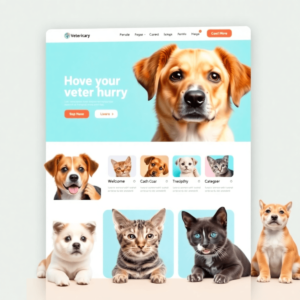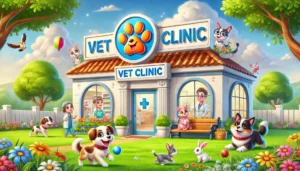Introduction
2024 is a crucial year for veterinary marketing. As the digital world changes, veterinarians need to use new strategies to reach pet owners and keep their practices successful. Good marketing isn’t just a choice—it’s necessary to stay competitive in this ever-changing industry.
In this guide, you’ll learn how to:
- Set specific campaign goals that match your practice’s objectives.
- Identify and divide your target audience so you can tailor your messaging effectively.
- Pick the right marketing channels, like Google PPC or social media, to maximize reach and engagement.
- Create appealing content that speaks to pet owners.
- Improve your campaigns for better results and return on investment (ROI).
- Use local SEO strategies to increase visibility in local searches.
- Implement scheduling and budgeting strategies for efficient ad spending.
- Stay ahead by keeping an eye on trends and adjusting your marketing strategies as needed.
- Regularly assess and improve your campaigns for continuous growth.
This guide provides practical tips to help you transform your marketing efforts and achieve sustainable growth and success in 2024.
1. Defining Campaign Goals
Establishing clear campaign goals is the cornerstone of a successful marketing strategy. For veterinary practices, these objectives not only provide direction but also measure progress and success.
Importance of Setting Clear Objectives:
- Focus and Direction: Clear goals prevent aimless efforts and ensure that every marketing activity aligns with desired outcomes.
- Measurable Success: Objectives allow for tangible metrics to track performance, facilitating continual improvement.
Common Goals for Veterinary Marketing Campaigns:
- Increasing Client Appointments: Whether targeting new pet owners or reminding current clients of upcoming check-ups, boosting appointment numbers is crucial.
- Enhancing Brand Awareness: Elevating your clinic’s profile within the community fosters trust and establishes a reputation as a go-to veterinary service.
- Promoting Services: Highlighting specialized services like dental care, emergency services, or exotic pet expertise can attract niche markets.
- Enhancing Client Engagement: Building a loyal client base through engaging content and proactive communication strengthens relationships and encourages repeat visits.
Setting these campaign goals early on positions your veterinary practice for strategic growth and measurable success.
2. Identifying Your Target Audience
Understanding your target market is the cornerstone of a successful marketing campaign for veterinarians. Audience segmentation allows for tailored messaging that speaks directly to potential clients’ needs and preferences.
Techniques for Identifying Demographics and Community Needs
1. Customer Demographics
- Analyze existing client data to identify common characteristics such as age, gender, income level, and location.
- Utilize software tools for deeper insights into pet ownership status, including type and number of pets owned.
2. Community Needs
- Conduct surveys and focus groups to gather firsthand information about what local pet owners value in veterinary services.
- Leverage social media platforms to monitor community discussions and trends related to pet care.
3. Behavioral Analysis
- Track website analytics to understand visitor behavior, including frequently visited pages and interaction patterns.
- Use CRM systems to segment clients based on their engagement history with your practice.
By precisely identifying your target audience, you can craft campaigns that resonate on a personal level, ensuring higher engagement and conversion rates.
3. Choosing the Right Marketing Channels
Selecting the appropriate marketing channels is crucial for veterinarians aiming to engage with pet owners effectively. Two primary channels stand out: Google PPC advertising and social media marketing.
Google PPC Advertising
Google Pay-Per-Click (PPC) advertising offers an excellent platform for connecting with pet owners who are actively searching for veterinary services. Here’s how to leverage this tool:
- Relevant Keywords: Start by identifying keywords that potential clients might use when searching for veterinary services, such as “veterinarian near me” or “pet care clinic.”
- Ad Groups: Organize your keywords into ad groups that align with your services. For example, create separate ad groups for vaccinations, dental care, or emergency services.
- Compelling Ad Copy: Develop engaging and persuasive ad copy that highlights the unique benefits of your practice. Include a strong call-to-action (CTA) such as “Book Now” or “Schedule a Visit Today.”
- Landing Pages: Ensure that each ad directs users to a relevant landing page on your website, providing additional information and a clear path to booking an appointment.
Social Media Marketing
Harnessing the power of social media platforms like Facebook and Instagram can significantly amplify your reach and engagement with pet owners:
- Targeted Ad Campaigns: Utilize the advanced targeting options available on these platforms to tailor your ads based on demographics, interests, and behaviors. For instance, target ads to pet owners within a 10-mile radius of your practice.
- Creative Content: Develop visually appealing ads that capture attention. Use high-quality images or videos showcasing happy pets and satisfied clients.
- Objectives Focused Approach:
- Awareness: Create campaigns aimed at increasing brand visibility among local pet owners.
- Consideration: Design ads that encourage users to visit your website or follow your social media pages for more information.
- Conversion: Focus on driving actions such as booking appointments or signing up for newsletters.
Best Practices
To ensure maximum effectiveness of your ad campaigns on platforms like Facebook and Instagram:
- A/B Testing: Regularly test different versions of your ads to determine what resonates best with your audience.
- Engagement Metrics: Monitor metrics such as likes, shares, comments, and click-through rates to gauge ad performance.
- Budget Allocation: Allocate budget based on campaign objectives and expected ROI. Invest more in high-performing ads while tweaking underperforming ones.
By strategically utilizing Google PPC advertising and social media marketing, veterinarians can build a robust online presence that attracts and retains loyal clients.
4. Creating Engaging Content That Resonates with Pet Owners
Engaging content is the foundation of any successful veterinary marketing strategy. By providing valuable information and establishing a strong connection with pet owners, veterinarians can build trust, increase client loyalty, and attract more appointments.
The Importance of Engaging Content in Veterinary Marketing
Content creation strategies are not just about filling up space; they are about meaningful engagement. High-quality content can:
- Educate pet owners on essential pet care practices.
- Showcase your expertise and reliability as a veterinarian.
- Create emotional connections that resonate with pet owners.
Types of Content That Appeal to Pet Owners
Understanding what type of content appeals to your audience is crucial. Some effective formats include:
- Blogs:
- Articles on common pet health issues, preventive care tips, and nutrition advice.
- Share real-life cases of pets that have benefited from your services.
- Tips on how to care for pets during different seasons or holidays.
- Videos:
- Demonstrations on administering medication or grooming techniques.
- Give a glimpse into a day at your veterinary practice to build transparency.
- Video reviews from satisfied clients to build credibility.
- Infographics:
- Visual representations of complex health topics made easy to digest.
- Quick tips on pet care that can be shared across social media platforms.
- Social Media Posts:
- Daily tips, fun facts, and interactive polls to keep your audience engaged.
- Announcements about special offers or community events.
By using these various content creation strategies, veterinarians can ensure their messaging resonates deeply with pet owners, fostering a loyal client base ready to turn to them for all their veterinary needs.
5. Optimizing Your Campaigns for Maximum Impact
Tracking performance metrics is crucial in elevating your PPC and social media campaigns to unprecedented heights. Metrics such as Click-Through Rate (CTR) and conversion rates serve as the heartbeat of your campaign’s effectiveness.
Key Performance Metrics to Monitor:
- Click-Through Rate (CTR): Measures the percentage of users who click on your ad after seeing it. A high CTR indicates that your ad is compelling and relevant to your audience.
- Conversion Rates: Tracks the percentage of users who complete a desired action, such as booking an appointment or signing up for a newsletter, after clicking on your ad.
Strategies for Optimization:
- A/B Testing: Experiment with different ad copies, headlines, and images to determine what resonates most with your audience.
- Keyword Refinement: Continuously update and refine your list of keywords based on performance data to ensure maximum relevance.
- Audience Segmentation: Tailor your messaging to different audience segments to enhance engagement and conversion.
- Budget Allocation: Reallocate your budget toward high-performing ads while pausing or revising underperforming ones.
Monitoring Tools:
- Google Analytics: Provides in-depth insights into user behavior and campaign performance.
- Facebook Ads Manager: Offers real-time data on ad performance, helping you make informed decisions quickly.
By systematically tracking and optimizing these metrics, veterinary practices can drive substantial improvements in their marketing campaigns, ensuring every dollar spent contributes to tangible growth.
6. Leveraging Local SEO Strategies to Boost Visibility in Local Searches
Local SEO strategies are vital for veterinarians aiming to dominate local searches and attract nearby pet owners. Integrating local SEO with your digital marketing efforts ensures your veterinary practice is easily discoverable when potential clients search for services in your area.
Key Components of Local SEO:
1. Google My Business (GMB) Optimization:
- Claim and Verify Your Listing: Ensure your practice is listed on Google My Business and verify it. This increases your visibility on Google Maps and local search results.
- Complete Your Profile: Add essential details—address, phone number, business hours, and photos of your practice. Ensure consistency with information on your website and other online directories.
- Collect and Respond to Reviews: Encourage satisfied clients to leave positive reviews and respond to them promptly. Positive feedback boosts your rankings in local search results.
2. Local Keywords Integration:
Use location-specific keywords throughout your website content, meta tags, and blog posts. For example, phrases like “veterinary clinic in [City]” or “best vets near [Neighborhood]” help search engines connect your practice with relevant local searches.
3. Citations and Listings:
Consistent NAP (Name, Address, Phone Number) across various online directories (Yelp, Yellow Pages) strengthens your local SEO profile. Discrepancies can confuse search engines and harm your rankings.
4. Localized Content Creation:
Create blog posts that address common local pet issues or events. Share stories about community involvement or partnerships with local shelters to engage with the community and enhance relevance.
5. Backlinks from Local Websites:
Building relationships with other local businesses or organizations can earn you valuable backlinks. These links act as endorsements for your practice, improving both domain authority and local search rankings.
Practical Example
Dr. Smith’s Animal Clinic leveraged local SEO by optimizing their GMB profile, collecting glowing reviews, integrating keywords like “24/7 vet service in Downtown,” and partnering with a nearby pet store for mutual backlinks. The result? A substantial increase in new client appointments from organic searches.
Combining these strategies with broader digital marketing efforts ensures comprehensive visibility, driving foot traffic into your practice while building a strong online presence aligned with community needs.
7. Implementing Effective Scheduling and Budgeting Strategies for Your Ads
Proper budgeting strategies are crucial in maximizing the efficiency of your marketing campaigns. Begin by setting realistic budgets that align with your expected costs and desired outcomes.
1. Set Realistic Budgets
- Daily vs. Monthly Budgets: Determine whether a daily or monthly budget best suits your campaign. Daily budgets help control spending on a more granular level, while monthly budgets provide flexibility over a longer period.
- Projected Costs: Estimate your costs based on historical data or industry benchmarks. Consider factors like ad platform, competition, and target audience to set a budget that’s both ambitious and attainable.
2. Schedule Ads Effectively
Effective scheduling ensures your ads reach potential clients when they are most active.
- Peak Times: Analyze when your target audience is most likely to engage with ads. Schedule ads to run during these peak times to maximize visibility and interaction.
- Seasonal Adjustments: Align ad schedules with seasonal trends or events relevant to pet owners. For example, increase ad activity during pet adoption months or national pet holidays.
Combining these strategies ensures that every dollar spent contributes towards achieving your veterinary practice’s marketing goals, fostering growth and client engagement seamlessly.
8. Staying Ahead by Monitoring Trends and Adapting Your Marketing Strategies Accordingly
In an ever-changing world, it’s crucial to stay informed about industry trends in veterinary marketing. This knowledge will help you stay relevant and competitive. 2024 is expected to bring new advancements that can improve your practice’s visibility and client engagement.
Key Strategies to Stay Updated:
- Follow Veterinary Industry Publications:
- Subscribe to leading journals and online platforms.
- Keep an eye on annual reports and studies for insights into emerging technologies and client preferences.
- Attend Conferences and Webinars:
- Participate in events like the AVMA Convention or Vet Shows.
- Network with industry leaders to gain firsthand knowledge of cutting-edge practices and tools.
- Leverage Social Media:
- Join professional groups on LinkedIn and Facebook.
- Engage in discussions to understand shifts in market dynamics and consumer behavior.
Adapting Marketing Strategies:
- Seasonal Campaigns: Align promotions with holidays, awareness months, or local events that resonate with pet owners.
- Technological Integration: Use advancements such as telemedicine or AI-driven customer service tools to enhance client experience.
- Content Evolution: Create content that reflects current concerns and interests of pet owners, such as new health trends or innovative pet care products.
By continuously monitoring these industry trends, your veterinary practice remains agile and responsive, ensuring sustained growth and relevance throughout the year.
9. Evaluating Your Results Regularly to Drive Continuous Improvement in Your Campaigns’ ROI
Campaign performance evaluation is a fundamental part of any successful veterinary marketing strategy. By conducting regular reviews, you can assess how well your campaigns are performing and pinpoint areas that need improvement.
Key Metrics to Monitor
- Click-Through Rate (CTR): This metric measures how effective your ad copy is at attracting potential clients.
- Conversion Rate: This indicates how often your ads lead to desired actions, like booking appointments.
- Cost Per Acquisition (CPA): This helps you determine how profitable your campaigns are by showing you how much you’re spending to acquire each new client.
Tools for Effective Evaluation
- Google Analytics: This tool provides detailed insights into website traffic and user behavior, helping you understand how visitors interact with your content.
- Facebook Insights: This tool gives you detailed data on post engagement, reach, and audience demographics for your social media campaigns.
- CRM Systems: These systems track client interactions and conversion rates, allowing you to measure the direct impact of your marketing efforts.
Steps for Continuous Improvement
- Set Benchmarks: Start by establishing initial performance benchmarks based on historical data or industry standards.
- Identify Trends: Look for patterns in the data that indicate what’s working and what needs adjustment.
- Iterate and Optimize: Use insights from your evaluations to make informed adjustments to ad copy, targeting parameters, and budget allocations.
Regularly evaluating the performance of your campaigns ensures that your marketing efforts remain flexible and effective, leading to continuous improvement in ROI.
10. Creative Hiring Process for Content Marketers in Veterinary Practice Marketing
Attracting top-tier talent to market your veterinary practice demands a strategic approach. Crafting creative job descriptions and leveraging industry best practices ensures you secure a content marketer who can elevate your brand.
Best Practices for Hiring a Content Marketer
1. Define Clear Objectives:
- Outline the specific goals you aim to achieve through content marketing, such as increasing web traffic, boosting client engagement, or enhancing brand visibility.
- Ensure the job description highlights these objectives clearly to attract candidates aligned with your vision.
2. Emphasize Industry-Specific Expertise:
- Prioritize candidates with experience in veterinary or healthcare marketing. Their understanding of industry nuances will be invaluable.
- Look for portfolios showcasing their ability to create engaging content tailored to pet owners’ needs.
3. Craft Creative Job Descriptions:
- Use vivid language that reflects the dynamic nature of your practice. Phrases like “Join our mission to make pet care accessible and engaging” can resonate more than generic job titles.
- Highlight unique aspects of your practice, such as community involvement or innovative services, to attract candidates passionate about your field.
4. Assess Content Creation Skills:
- Request writing samples or a portfolio demonstrating a range of content types, including blogs, social media posts, and videos.
- Conduct practical tests where candidates create sample content based on hypothetical scenarios relevant to your practice.
5. Evaluate Adaptability and Innovation:
- Seek individuals who stay updated with digital marketing trends and show a willingness to adapt strategies accordingly.
- During interviews, ask questions that gauge their ability to incorporate new technologies or platforms into their content strategy.
6. Foster an Inclusive Hiring Process:
- Ensure diversity in your hiring process by reaching out to varied talent pools and avoiding biases.
- Implement structured interviews and standardized evaluation criteria to maintain fairness.
By adhering to these best practices, you can attract a content marketer who not only understands the intricacies of veterinary marketing but also brings creativity and innovation to the table. This positions your practice at the forefront of digital marketing excellence in 2024.
Conclusion & Call to Action
Implementing these veterinary practice success strategies for 2024 can transform the way you connect with pet owners and enhance your clinic’s reputation. By defining clear goals, identifying your target audience, choosing the right marketing channels, and creating engaging content, you’re setting a strong foundation for success. Optimize your campaigns, leverage local SEO, and stay ahead of industry trends to ensure continuous improvement.
Ready to elevate your veterinary practice marketing?
Reach out to AVI Lead Generation Pets today. Our expert strategies are designed to resonate with your target audience and drive tangible results. Let’s make 2024 a landmark year for your veterinary practice!








